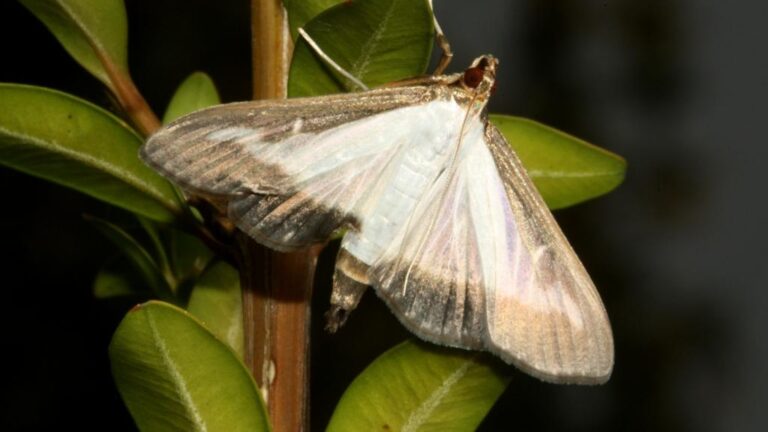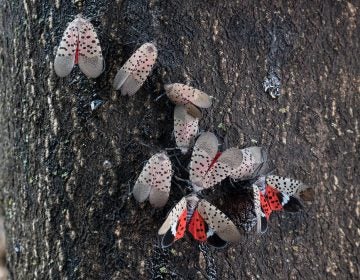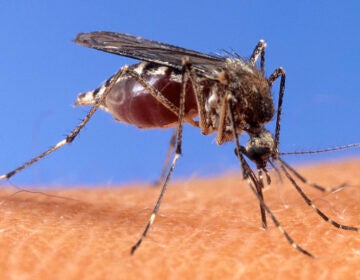Invasive box tree moth spotted in Pennsylvania. Here’s what to know about the threat it poses and how to control it
The box tree moth, which originally hails from Asia, has only one victim: boxwoods, a non-native shrub commonly used for hedging and topiary.
Listen 1:08
An adult box tree moth. (U.S. Department of Agriculture)
From Philly and the Pa. suburbs to South Jersey and Delaware, what would you like WHYY News to cover? Let us know!
Move over spotted lanternfly — there’s a new invasive insect in town.
Earlier this week, the Pennsylvania Department of Agriculture announced that the “highly destructive” box tree moth, which originally hails from Asia, has officially entered the state.
The moth was spotted in two Erie County cemeteries, which are now quarantined. It has also appeared in Delaware, Massachusetts, Michigan, New York, Ohio and Ontario, Canada.
The good news is, unlike the spotted lanternfly, which harms a wide range of plants, the box tree moth has only one victim: boxwoods, a non-native shrub commonly used for hedging and topiary.
“It’s one of the most popular ornamentals,” said entomologist Michael Skvarla, an assistant research professor at Penn State who runs their Insect Identification Laboratory. “So, yay — it’s not going to hurt native ecosystems, but it is going to have a sizable impact because boxwood is so extremely popular all over the place.”
Impact on Pennsylvania’s green industry
The Pennsylvania Landscape & Nursery Association (PLNA), a trade association comprising wholesale nurseries, greenhouses, landscape contractors and retail garden centers, has been tracking the progress of the box tree moth for several years, at least since it appeared in the U.S. in 2021.
Gregg Robertson, who represents the PLNA’s legislative, regulatory and policy interests, says that although Pennsylvania is not among the top 10 states producing boxwoods, the moth could do real harm to individual producers.
“For the industry as a whole, it’s not a big deal economically,” Robertson said. “However, for those nurseries producing boxwoods, it is a big deal. One of the largest boxwood producers in Pennsylvania is in Erie County. They account for a substantial portion of Pennsylvania’s overall boxwood production. Monitoring and treating for the pest (if it is found) will increase their boxwood production costs.”
The moth could also prove challenging for locales that house a lot of boxwoods, such as residential and commercial landscapes, and may eventually lead to a decline in the plants’ popularity.
The box tree moth is the latest in a succession of stressors for Pennsylvania’s nursery industry, which has faced challenges since the Great Recession of 2008.
“This is due to many factors such as increasing land costs, pressure due to urbanization, increasing production costs, invasive species, labor shortages and inadequate succession planning on the part of aging-out nursery owners,” Robertson said. “Box tree moths could be the proverbial straw for some smaller producers that grow boxwoods.”
Other recent invasive threats to boxwoods and beyond include boxwood blight, a fungal disease that can kill boxwoods, and the emerald ash borer, an Asian beetle that has wiped out hundreds of millions of ash trees across the state, leading to heavy losses for many Pennsylvania nurseries.
“We are now concerned about vascular stem disease, which affects primarily red buds, red maples and dogwoods, three extremely valuable and popular tree species,” Robertson said. “It affects primarily nursery stock and is present in states south of Pennsylvania, such as Virginia. We don’t know much about the cause or the cure, but it can render entire blocks of these trees in a nursery unsaleable.”
Identifying box tree moths
Most adult box tree moths are primarily white, with a border of brown along the edges of their wings. Around 5% are completely brown. Skvarla says they bear a slight resemblance to melonworm moths, which are native to North America, but are otherwise distinctive for our area.
By the time you’re noticing moths, however, the damage may already be done.
“The caterpillar stage is the most damaging stage,” Skvarla said. “It’s the almost mature caterpillars that are doing the majority of feeding. It can kill boxwoods quickly. There are some reports that boxwoods will die within a year of heavy feeding. Part of the problem is the caterpillars, especially in heavy infestations, will strip all of the leaves off of the boxwood. Once they strip the leaves, if they’re still hungry, they’ll start chewing on the bark.”
Boxwoods may be able to recover from damage to their leaves, but once the caterpillars start stripping the bark, entire branches can die off — which can mean death for the plants.
“Even if they do recover, the shape of the bush is often lost,” Skvarla said. “So there goes the aesthetic value of having them in ornamental planting.”
The caterpillars are lime green with yellow, white and black stripes running along each side.
But the easiest way to identify them, Skvarla says, may be simply to keep an eye on your boxwoods.
“There are no other caterpillar pests on boxwood in North America,” Skvarla said. “So if you find a caterpillar on boxwoods, it’s a pretty good guess that it’s going to be a box tree moth.”
Dealing with box tree moths
Unlike with spotted lanternflies, Skvarla doesn’t recommend stomping any and all caterpillars or moths that you think might be box trees.
“Most times, private homeowners are going to be aware of infestations because of the damage they see to their boxwoods, not because of the moths that they’re seeing flying around,” he said. “So if your boxwood is really damaged, that’s the time to start going, ‘Well, maybe this is a box tree moth. I should look further, look for caterpillars, maybe look for moths.'”
The first step for anyone who suspects they might have an infestation is to monitor their boxwoods, says Patricia Prade, an entomologist with Penn State Extension who specializes in controlling pests and invasive species.
“You need to know if you have this insect,” Prade said. “So you need to constantly check if you see any larvae.”
One way to confirm whether or not you have an infestation is to purchase pheromone traps geared specifically toward box tree moths.
Prade says there are a few options for curbing box tree moths. Her first suggestion is to simply pluck them off, or trim away the infested areas.
“If you’re a homeowner, for example, and you see some caterpillars, you can handpick them and kill them easily,” she said. “It can be challenging if you have a lot of plants infested, but if you have just a couple, you can cut a branch or something like that. That’s very targeted, right? It’s a very good way to control them fast and not to just spray chemicals on the environment.”
Because box tree moths are so new, Prade says, studies are still being done to find out what chemicals are most effective against them while being the least damaging to other life. In the meantime, she says, homeowners can seek out pesticides targeted toward caterpillars, which are likely to kill box tree moths.
When will box tree moths reach Philadelphia?
Skvarla and Prade say it’s hard to forecast when box tree moths will reach our area — or whether and how we’ll be able to control them.
“Often when an invasive species is in an area, it’s very hard to eradicate them — it’s not impossible, but it’s very hard,” Prade said. “But I believe that as we learn more about this species — what is working to control it, if there are any native insects or mammals or birds that can eat this caterpillar— we’re probably going to have a better way of controlling it.”
Prade says the U.S. Department of Agriculture is currently studying parasitoid wasps from the moth’s native habitat that may be able to help control the box tree moth population, but added that it takes a long time before new biocontrol agents are allowed to be released in a country.
“Right now, we don’t know exactly how it’s going to play out, to be honest,” she said.
Skvarla added that past experiences aren’t necessarily instructive when it comes to making predictions because box tree moths have such a limited diet compared with other invasive pests.
“I think it’s a really kind of interesting situation because with a lot of other invasives, things like spongy moth, formerly known as gypsy moths, and spotted lanternflies, they feed on native plants — that’s part of the reason that they’re so invasive and so damaging,” Skvarla said. “Here we’ve got a pest that only feeds on ornamentals and only one very specific kind of ornamental. An ornamental that is planted primarily in urban and suburban areas, you’ll find it in rural areas, but they’re much more spread out than in more urbanized places. So it’s going to be harder for them to spread between urban centers without human mediated transport.”
Prade added one last piece of advice.
“People don’t have to panic,” she said. “People get scared because of the problem we had with the spotted lanternfly, but people just don’t have to panic.”
For more information about the box tree moth, visit the Penn State Extension website.

Get daily updates from WHYY News!
WHYY is your source for fact-based, in-depth journalism and information. As a nonprofit organization, we rely on financial support from readers like you. Please give today.






